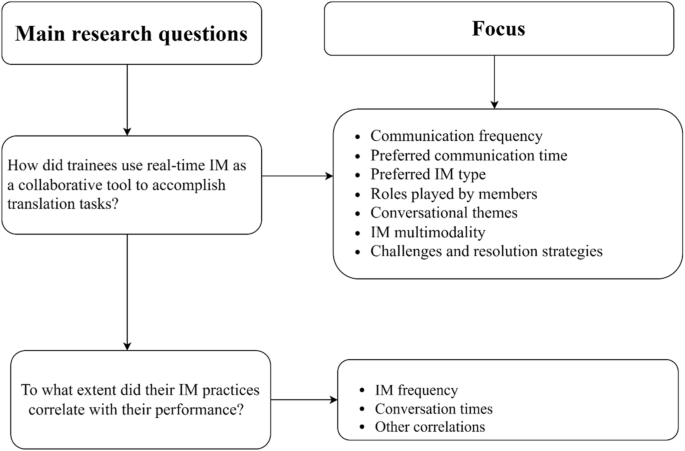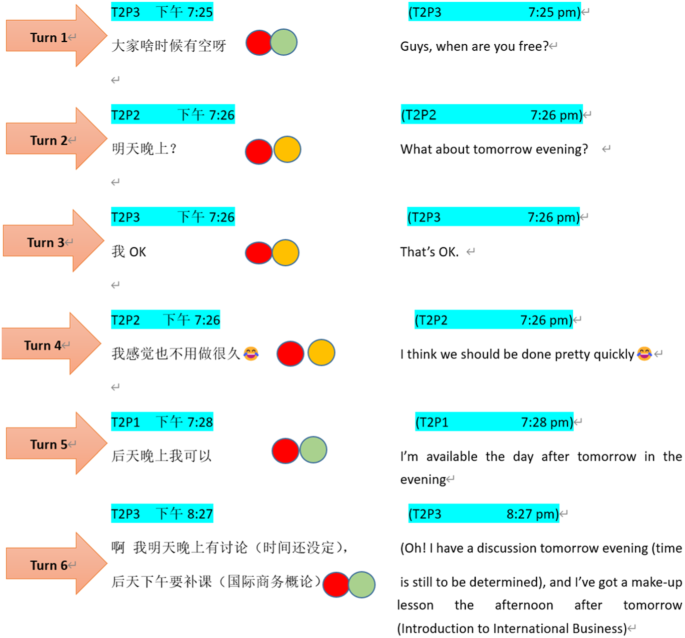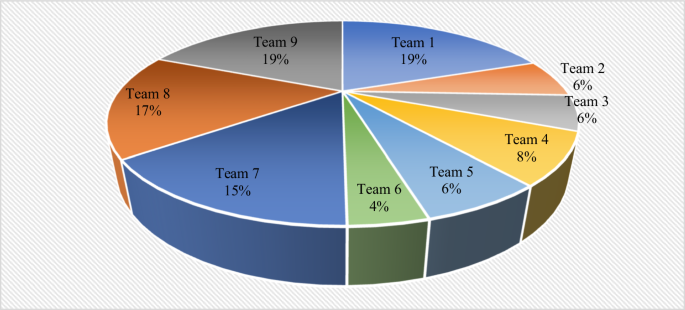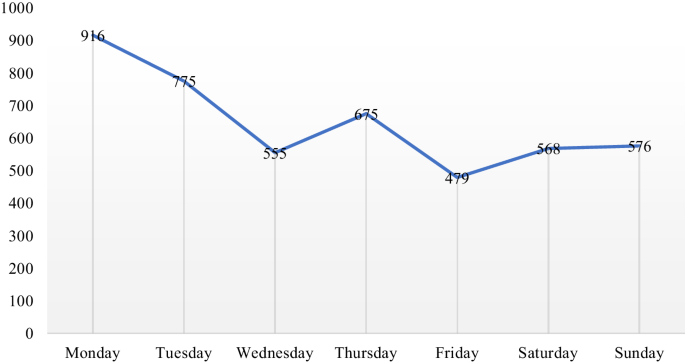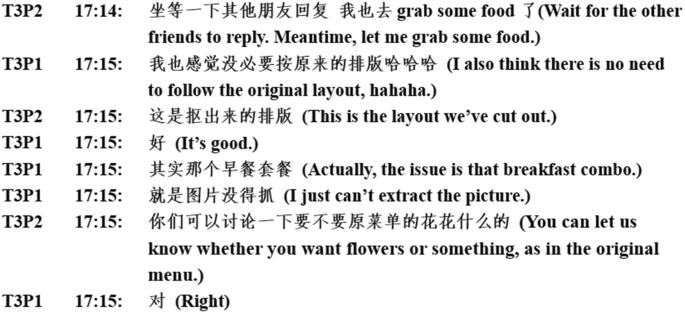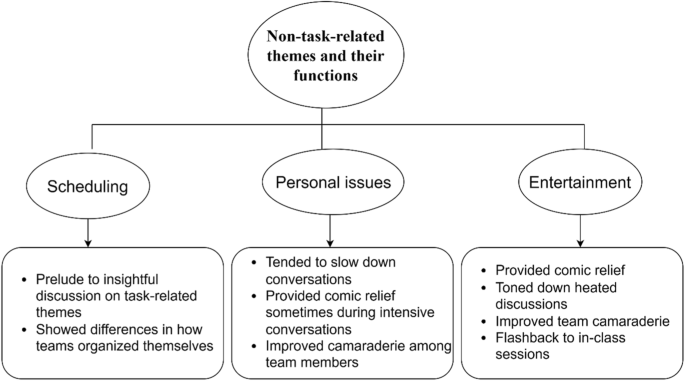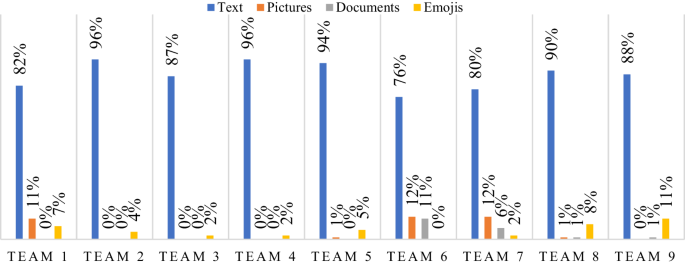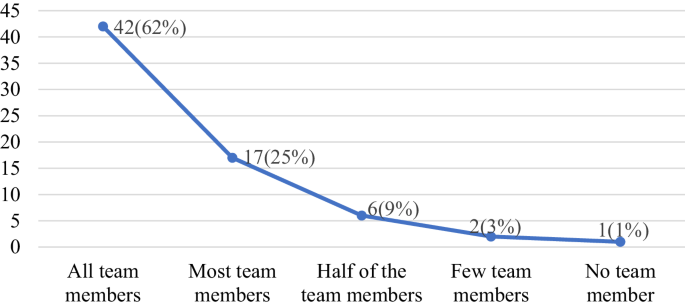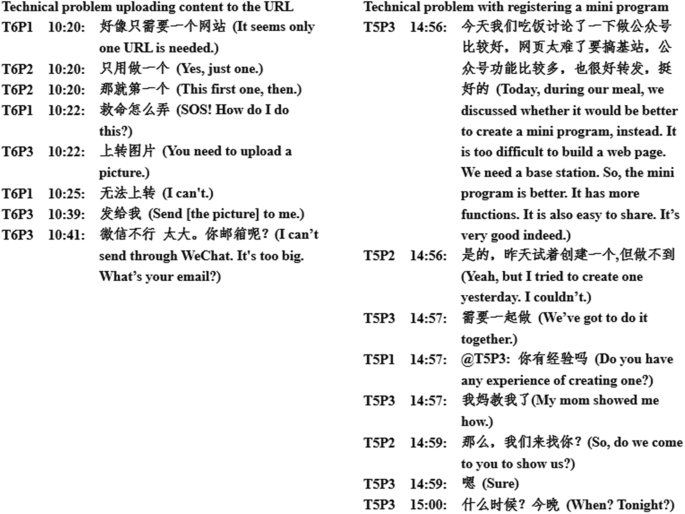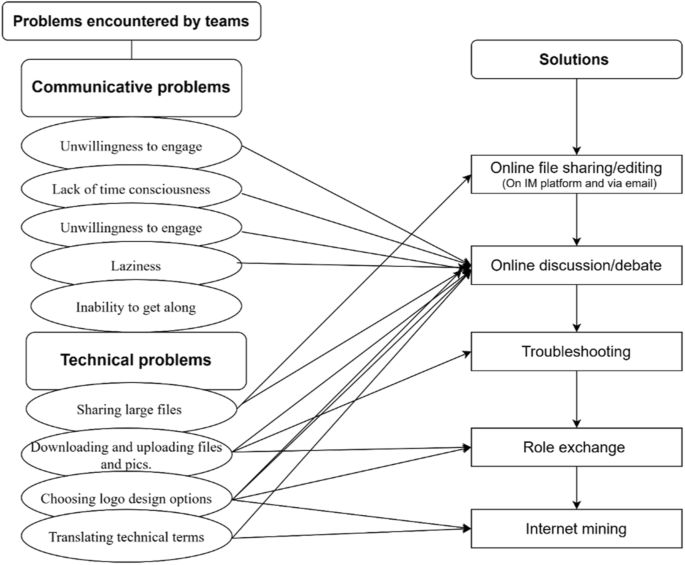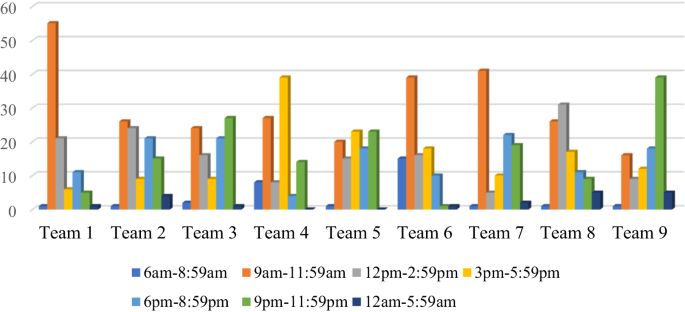Abstract
Web 2.0 technologies have had a significant impact on collaborative communication practices in teaching, learning, and professional work environments. In translation studies, computer-supported collaborative translation tasks have mainly been discussed within the project-based learning framework, where research has foregrounded correlations between collaboration and performance. However, trainees’ specific uses of collaborative tools, including transcripts of real-time exchanges, have neither been sufficiently investigated nor informed pedagogical strategies and approaches in any tangible way. This study bridges this gap by evaluating trainees’ collaborative practices while they translated a text, localized a restaurant menu, and simulated the design and launch of a language service agency. Data was gathered from a questionnaire, in-class presentations, and real-time instant messaging (IM) transcripts. Data analysis of the real-time IM exchanges unveiled considerable trainee communicative practices during collaborative tasks. Furthermore, correlations were established between the volume of instant messages, time of exchange, role played by trainees, and conversation themes with the teams’ final assessment performances. This study provided valuable insights into the effectiveness of IM as a collaborative tool in training environments. It also informed our suggested guidelines for properly integrating IM into the translator training curriculum.
Similar content being viewed by others
Introduction
Web 2.0 technology use, including social media and instant messaging (IM) by translation professionals, has been central in the discourse of the past decade (Desjardins, 2011; García, 2010; Pym, 2011). The use of IM is predominantly a result of its ubiquity, portability, availability, locatability, and multimodality (Schrock, 2015) following rapid advances in technological development. Consequently, modern professional workplaces have become inherently collaborative, turning IM into a core communication tool between translators and their peers, project managers, clients, and subject experts (Kerremans et al., 2019).
Undoubtedly, the technology-driven professional environment has a bearing on translator training, with an increasing number of calls, some backed by empirical research, to align training with the realities of the industry (Su and Li, 2023). Monti (2012), for instance, has recommended the integration of Web 2.0 in translator training, arguing that trainers should “take into account these emerging trends and should adopt cooperative teaching models based on the new translation technologies, which allow the simulation of real work contexts” (p. 797). In her appeal to integrate Facebook into translator training, Desjardins (2011) has argued that “social networking sites can be incorporated [into translator training] in ways that foster complex learning provided students are taught to use them judiciously” (p. 187). Therefore, to heed these calls, trainers have adopted various training models, including project-based learning (PjBL), in order to emphasize autonomy, engage learners as they resolve real-life problems, develop trainees’ critical thinking skills, and foreground collaboration.
Regarding the application of PjBL to translator training, researchers (Kerremans et al., 2019; Tekwa, 2020) have profoundly explored the contribution of IM to completing collaborative tasks. However, while there appears to be a consensus on the cruciality of information exchange during collaborative translation tasks, thorough investigations have not been undertaken to explain how such interactions occur, what role interlocutors play, how IM practices are related to translation performance, and how IM use could be optimized via moderation and guidance. In addition, the practical use of IM in collaborative translation tasks has not been sufficiently observed to lay solid groundwork for its adequate integration in collaborative translation tasks within the PjBL framework.
Therefore, this study evaluates the practical employment of real-time IM by 68 trainee translators (nine teams) working collaboratively on translation, localization, and language service provision (LSP) tasks. Real-time IM exchanges provided voluntarily by trainees, their in-class presentations, and responses to a questionnaire were gathered and analyzed to explore how trainees worked together to perform the assigned tasks. In particular, the analysis focused on trainees’ IM practices, including how often, on which days, and at what times they exchanged IM; their preferred (synchronous or asynchronous) IM form; how they resolved task-related problems; and whether they assumed or were assigned roles. Finally, the data were analyzed to determine whether trainees’ IM practices correlated with their final assessment of the three tasks. Based on the study’s findings, guidelines were suggested for integrating IM as a collaborative tool in PjBL.
Project-based learning and communication challenges in collaborative tasks
Project-based learning ((PjBL), or “the translation task and project-based approach” (Hurtado Albir, 2015, p. 256), encourages students to develop problem-solving, critical thinking, and collaborative skills based on empirical evidence from translation classrooms (e.g., Li et al., 2015). Therefore, we believe that project-based learning, especially group-oriented project-based learning is a valuable framework for the present study to design and implement the collaborative tasks in translator training. One of the foundational tenets of PjBL is collaborative or group work, where students “work together, share their findings, and decide how to best represent their new knowledge” (Li et al., 2015, p.3). That means for group-oriented PjBL to be successful, members need to have minimum communication skills. Therefore, for PjBL to achieve its expected outcomes, learners must be able to communicate with each other.
Due to technological advances, much of the communication in today’s PjBL tasks is computer-mediated. That means information is shared via various media, including IM and other chat-based platforms, web conferencing, video conferencing, traditional text messages, and other digital communication networks (Zafirov, 2013). Even though it has been associated with higher performance, computer-mediated communication poses non-negligible challenges within the group collaboration framework. For instance, Moghaddas and Khoshsaligheh (2019) found that trainees are easily distracted during conversations, while García González and Veiga Díaz (2015) concluded that collaborative exchanges are time-consuming and members lack teamwork experience. Similarly, Apandi and Afiah (2019) raised concerns regarding the prior readiness of trainees and trainers, the difficulty of introverted trainees adapting, the challenges of accessing physical locations to observe teams at work, and the translation of culture-bound words. Furthermore, researchers have investigated the IM communication habits of teams engaged in PjBL-based tasks, concluding that high-performing teams start early, are consistent in their exchanges, develop camaraderie, are better organized, and engage in deep, rich, and thought-provoking conversations. In contrast, low-performing teams start slowly, are inconsistent and erratic, are poorly organized, and engage in shallow exchanges (Thomas and MacGregor, 2005).
Meanwhile, in terms of PjBL methodologies adopted, researchers have tended to rely on questionnaires, observations, presentations, or periodic reports. For instance, Pitkäsalo and Ketola (2018) based their analysis of trainee collaborative practices and exchanges on periodically submitted group reports, while Apandi and Afiah (2019), García González and Veiga Díaz (2015), Moghaddas and Khoshsaligheh (2019), Li et al. (2015), Prieto-Velasco and Fuentes-Luque (2016), and Martins and Ferreira (2019) adopted either a single approach or a combination of approaches, including instructor observations, reports, presentations, and semi-structured interviews in their assessment of how trainees collaborated during translation tasks. Though useful in their insightful conclusions, these approaches revealed that the raw data of trainees’ IM exchanges have not been adequately explored to understand learners’ IM group task communicative practices. In our opinion, this represents a significant research gap worthy of filling, especially given that within the industry, there have been calls for increased collaboration among professionals, including via current mobile messaging platforms (Désilets and Van Der Meer, 2011; Gough, 2011).
Therefore, conversant with some of the IM challenges outlined above, we designed this study to focus on real-time IMs shared by groups performing collaborative tasks within the PjBL framework. In other words, we analyzed trainees’ conversation transcripts and questionnaire responses to answer two fundamental questions:
-
1.
How did trainees use real-time IM as a collaborative tool to accomplish translation tasks?
-
2.
To what extent did their IM practices correlate with their performance?
The two fundamental research questions comprise sub-areas, as outlined in Fig. 1 below.
Methodology
This section discusses the participants, study design (i.e., task objectives, pre-task, task execution, reporting, and assessment), and data collection and analysis. The data collection section equally underscores the mixed methods used by describing the quantitative and qualitative data collection, instruments, and analyses.
Participants
In total, 68 trainees (female: n = 58; male: n = 10) participated in the study. They were first-year students in the professional Masters of Translation and Interpreting (MTI) program at a Chinese university. They were enrolled in the mandatory Language Services and Project Management (LS&PM) course designed to provide students with broad practical and theoretical knowledge of the translation industry and guide them toward making potential career choices within the expanding profession. The course introduces trainees to translation (e.g., computer-assisted translation (CAT), machine translation (MT), machine translation postediting (MTPE), and translation techniques), localization (e.g., websites, menus, tools, and resources), and project management (e.g., processes, deadlines, industry practices, tools, and resources). The LS&PM course runs in the fall semester of each academic year and lasts 16 weeks, from early September to early January. The trainees formed nine teams, each comprising eight or nine members who voluntarily agreed to work together.
Task design
The teams had to complete three tasks: translate a text, localize a menu, and design and launch an LSP agency. Regarding technology use, the translation and localization tasks had to be accomplished on the Smartcat and POEditor CAT tools. In contrast, the LSP task used a WeChat mini-program designed and launched on the social media platform (Lin et al., 2020) that allows companies and individuals to develop, launch, and disseminate applications, products, services, news, and business information in multiple formats.
A class WeChat group was created to facilitate communication. Then, each team created a separate WeChat group to facilitate exchanges while accomplishing the tasks. Therefore, in addition to face-to-face meetings, IM was the primary means of communication. WeChat was chosen as the IM platform because it is a learning tool (Hou et al., 2021; Shi et al., 2017; Xue et al., 2021) and, arguably, China’s most popular messaging application, meaning trainees used it daily for multiple reasons, including exchanging messages, voicemails, calls, photos, documents, and pictures. Though the teams met offline whenever necessary, it is noteworthy that solely their raw IM exchanges were analyzed within the context of this study.
Tasks
The tasks had different objectives, as illustrated in Table 1.
The translation task required trainees to collaborate in translating (from Chinese to English) a text of approximately 2500 characters using the Smartcat CAT tool. The teams had two weeks to accomplish the task, i.e., use the tool, discuss, and agree upon target text equivalents. They had to use the MT function of the tool and post-edit the output, thereby developing their technological, textual, terminological, and collaborative competencies and other skills (e.g., leadership, team player, and time management) necessary to succeed in today’s industry (Kiraly, 2005).
Concerning the localization task, the trainees were requested to adapt the menu of a Chinese restaurant hypothetically setting up shop in New York City in a predominantly white, middle-income neighborhood where spicy food is unpopular and half of the population is vegan. Therefore, the task required them to think critically and adapt the menu by adding, removing, or modifying ingredients, improving the design, describing dishes, and employing persuasive language. Each task lasted two weeks, during which members used various technologies and exchanged IM as they worked together.
Furthermore, regarding designing and launching an LSP, the trainees were expected to either use any current LSP as their model or brainstorm creative and innovative ideas to meet current and future clients’ multiple needs. The tasks required collaborative work, critical thinking, and information mining on websites, applications, and other mini-programs. The teams also had to design the mini-program and employ marketing language (emotional, functional, descriptive, formatting, and positioning). Each project had to be accomplished within a specific time frame, informed by a workflow (Hurtado Albir, 2015; Kiraly, 2005), which included the pre-task, task execution, reporting, revision, and assessment stages.
Pre-tasks
Before the trainees performed the assigned tasks, they had practical in-class training that lasted for three weeks. Specifically, they received theory-based lectures on localization, translation, project management, and language services. In addition, they had hands-on practice using technology tools, simulated short-duration group tasks and took a short quiz to ensure they were familiar with the tools and processes. The pre-task also allowed them to work in teams and practice exchanging IM, discussing challenges, and building trust and confidence. During the pre-task, team members sent and received instant messages via the class WeChat group, which included the instructor. This was a crucial opportunity for the instructor to answer questions, guide the exchanges, and ensure that instructions for the tasks were precise, concise, understood, and followed.
Task execution
The tasks, instructions, due dates, and tools to use were transmitted to the teams via the class WeChat group. Thereafter, the instructor mainly functioned as a guide. Meanwhile, the trained worked collaboratively in teams, conversing face-to-face or exchanging IM on their team WeChat group. They could return to the class WeChat group and ask questions to the instructor or other team members. Project-based learning mainly occurred at this phase, where trainees relied on their critical thinking skills while interacting with their team members to develop heuristics useful in real professional workplaces.
Reporting
Each week, in class, the teams reported on their progress and the roles assigned to or taken up voluntarily by members. They also discussed the challenges encountered and measures taken to resolve them, their teamwork atmosphere, and their level of camaraderie. Most often, teams that had faced the same problems shared their perspectives and experiences given that the “ways and means of accomplishing … goals vary greatly from group to group, from project to project and from student to student” (Kiraly, 2005, p. 1109). Meanwhile, the instructor offered advice and guidance and, most importantly, gathered data on team members’ roles.
Assessment
The translation task was assessed based on rubrics and assessment methods suggested by Hurtado Albir (2015), albeit slightly modified to reflect specific trainee learning needs (see Supplementary Appendix 2). The instructor provided feedback after reviewing the teams’ final translation. The localization task was assessed based on how well the menu was translated and adapted (taste, item descriptions, rare ingredient descriptions, layout, measurements, price, color, and selling language) for local diners and how the teams justified terminological and design-based choices during their presentations (see Supplementary Appendix 3). As for the LSP task, the trainees were assessed on the design, effectiveness of the business language, services offered, ability to track and quickly respond to client requests, and project management procedures (see Supplementary Appendix 4).
Data collection and analysis
Data were gathered through a questionnaire on trainees’ IM communication practices and experiences. Furthermore, in-class presentations, interviews with trainees, and raw IM exchanges voluntarily provided by the teams at the end of the semester were analyzed to obtain various findings.
Questionnaire
The questionnaire gathered data from individual trainees who worked collaboratively and communicated via IM after they provided their consent for the data to be analyzed within the framework of this study. In particular, the questionnaire comprised eight questions, focusing on the trainees’ perceptions of their team’s level of camaraderie, members’ IM exchange practices, problems encountered, problem-resolution strategies, and team members’ attitudes within the context of the problem-based collaborative tasks. The questionnaire comprised mainly Likert scale–type questions to facilitate data collection, given that it took participants only an average of 73.23 s to complete.
Real instant message exchanges and in-class presentation data
During the weekly in-class presentations, data were gathered on task organization and the roles assigned to or voluntarily taken up by team members. The nine teams each voluntarily provided their corpus of IM conversations at the semester’s end. The data comprised 78,138 Chinese characters and English words forwarded as Microsoft WordPad files to the instructor via email. There were 4544 IM turns, defined as “one line from one participant that ends at the point the participant presses ‘enter’ and sends the transmission to his or her interlocutor” (MacKiewicz and Lam, 2009, p. 419).
The IM exchanges were downloaded and pre-treated for analysis. The conversations of each team were pre-treated individually and carefully verified by two assistants hired for this purpose. Specifically, IM turns that contained pertinent information were color-coded using different colors, as outlined in Table 2 below.
Synchronous IM exchanges were considered to be messages sent back and forth within intervals of less than 60 seconds. In other words, for an exchange to be considered synchronous, a reply had to occur within 60 seconds (MacKiewicz and Lam, 2009). Whenever a turn contained information belonging to two or more categories, the colors were aligned next to each other to facilitate tallying. For example, if trainees engaged in synchronous exchanges about a specific theme, such as scheduling, two colors (red and orange) were used to identify the theme and the IM exchange form, as illustrated in Fig. 2 below.
The six turns above discussed one theme, i.e., scheduling, identified using red. However, turns 1, 5, and 6 were asynchronous exchanges (they occurred at different times and were represented with the green color), while turns 2, 3, and 4 were synchronous exchanges (they all occurred at 7:26 pm) and were coded using orange. The IM exchange categories of each team were identically marked and then tallied to obtain means and standard deviations.
Data analysis
The questionnaire responses were downloaded from the website of free online surveys into an Excel spreadsheet and then uploaded to the SPSS software for further analysis. The questionnaire was internally consistent given that it had a Cronbach’s alpha value of α = 0.89. Furthermore, SPSS was utilized to calculate the means, standard deviations, Pearson’s correlation coefficient of several variables, and T-tests that determined statistical variances among the variables. Meanwhile, we conducted thematic analyses of trainees’ interviews to extract textual information that underpins the trainees’ IM exchanges.
Results
How trainees used real-time IM as a collaborative tool to accomplish translation tasks
To understand the extent to which trainees utilized IM to accomplish the assigned tasks, we investigated the frequency of exchanges, preferred communication time and day, preferred communication forms, the role played by members, themes discussed, the extent of IM multimodality, and communicative and technical challenges and how they were resolved.
The top-performing teams communicated better than the bottom-performing teams
Communication frequency
We found significant differences in the volume of IM exchanges, with the top-performing teams communicating significantly more frequently while working on the three tasks. The data of IM exchanges showed that Teams 1, 7, 8, and 9 exchanged 887, 848, 756, and 678 IM turns, respectively. The volume of IM turns exchanged by the four teams accounted for over half of the total IM exchanges. In contrast, the bottom-performing teams, namely Teams 2, 3, 4, 5, and 6, exchanged 357, 297, 279, 255, and 187 IM turns, respectively, as presented in Fig. 3 below.
Preferred communication day and times
We then examined whether the teams preferred to exchange IM on specific days and time slots. One reason was to understand how close to or far away from the day of the lesson and how late into the night teams discussed. We assumed that such knowledge might be instrumental in designing future collaborative tasks and guiding IM exchanges within translation tasks and PjBL.
Our data indicated that participants exchanged the most instant messages (20%) on Monday, the day of the lesson, and Tuesday (17%), the day following the lesson, as presented in Fig. 4 below.
In contrast, teams exchanged the least IM on Friday (four days after the lesson). However, as the lesson day approached, the volume of exchanges gradually increased on Saturday and Sunday. Upon further analysis, we found that messages exchanged prior to, on, or the day after the class often centered around the core themes, i.e., were devoid of non-task-related themes and issues. For instance, Conversation 1 in Fig. 5 is an excerpt of a task-focused IM conversation by Team 8 members on the day before the lesson.
In terms of the communication times, we divided the day into multiple three-hour time slots (6 am–8:59 am/9 am–11:59 am/12:00 pm–2:59 pm/3:00 pm–5:59 pm/6:00 pm–8:59 pm/9:00 pm–11:59 pm) and a six-hour time slot (12:00 am–5:59 am). Then, we tallied the number of IM turns exchanged within each time slot. We also found that the most unpopular time slots were early in the morning, between 6:00 am and 8:59 am, and after midnight, between 12:00 pm and 5:59 am. The data also showed that Teams 9, 5, and 3 preferred communicating between 9:00 pm and 11:59 pm, relatively late at night.
Preferred IM type
The study intended to understand whether participants preferred synchronous or asynchronous conversations and whether the preferred conversation mode had a bearing on their performance. Our data analysis showed that participants engaged more in synchronous (3228 turns, 71%) than asynchronous (1317 turns, 29%) conversations (Fig. 6).
In terms of conversation type per team, we found that Team 1 sent the most synchronous IM turns (83.2%) and the fewest asynchronous (16.8%) IM turns (Fig. 6). In contrast, Team 3 exchanged the fewest (60%) synchronous and the most (40%) asynchronous IM turns. We also found that overall, teams exchanged 60% or more synchronous IM turns, making this form of communication the most preferred. Our data further showed that during synchronous IM, participants brainstormed ideas, seldom derailing from the topic. For instance, in Conversation 2 (Fig. 7) below, members of Team 3 discussed their menu layout (localization task) synchronously, sticking to the topic of conversation.
In terms of correlation with the final assessment, there was a high positive correlation between synchronous exchanges and the final assessment [r(9) = 0.74, p = 0.022, i.e., non-significant] and a high negative correlation between asynchronous exchanges and the final assessment [r(9) = –0.88, p = <0.002, significant]. The data corroborated previous findings, indicating that synchronous communication encourages brainstorming and fosters more productive exchanges than asynchronous communication (Thomas and MacGregor, 2005).
Roles played by members
The data gathered during the weekly team in-class presentations revealed that teams employed two methods to fill seven fundamental roles. According to the data, roles were either assigned to members permanently or on an ad hoc basis or were voluntarily taken up by members (Fig. 8).
In particular, Teams 1, 7, 8, and 9 (top-performing teams) identified four crucial roles (i.e., team lead, terminology manager, timekeeper, and secretary), which were filled permanently regardless of the task they performed (Table 3). While the team lead oversaw the entire project, the terminology manager documented, stored, and updated term records. Meanwhile, the timekeeper reminded members about deadlines, and the secretary recorded the challenges encountered and a list of questions to discuss in class or ask the trainer.
In contrast, Teams 2, 3, 4, 5, and 6 (low-performing teams) had only one permanent role, team lead, which they filled consistently (Table 3). The other roles were assigned to members or were voluntarily filled on an ad hoc basis. For instance, the team lead of Team 6 assigned a “competent” member to manage terminology while other members translated the document.
The data also showed that most roles were assigned during the LSP design and launch task, which required a content writer/creator, data miner, page designer, and members with practical knowledge of WeChat mini-programs. Furthermore, regarding team organization and role play, we found discrepancies between high- and low-performing teams that reflected their performance in the final assessment score.
Conversational themes
Our data analysis showed that participants discussed multiple themes, some of which were not directly related to the tasks assigned. While task-related themes included localization, translation, LSP, scheduling, and planning, non-task-related themes included gossip, personal issues, and entertainment (e.g., meals, games, concerts, and music). It was also found that most IM exchanges (33%) occurred when teams discussed the LSP design and launch task. Furthermore, trainees also exchanged more IMs when performing the localization task (31%) than the translation task (26%).
In terms of non-task-related IM exchanges, we found that team members discussed personal issues (1%), entertainment (1%), gossip (4%), and scheduling-related issues (4%). However, we found significant discrepancies in how the teams discussed themes unrelated to the assigned task (Table 4). For instance, 14% of the IM exchanges of Team 4, one of the low-performing teams, were gossip, while 13% of the IM exchanges of Team 2, another low-performing team, were entertainment.
Furthermore, we analyzed the transcripts of the teams’ IM exchanges and found that gossip played a significant role. For instance, 7% of the instant messages exchanged by members of Teams 9 and 3 were gossip. However, while Team 9, a top-performing team, used gossip to transition to other themes, Team 3 appeared to gossip for gossip’s sake. For their part, Team 8 and Team 9 extensively discussed scheduling issues that accounted for 10% and 15% of the total volume of IMs exchanged. While the themes of gossip and entertainment suggested a degree of camaraderie among team members, as indicated in the survey findings, the lengthy exchanges on scheduling appeared to corroborate the questionnaire responses of some trainees who perceived IM exchanges to be time-consuming. We equally noted that non-task-related themes had several functions, as outlined in Fig. 9 below.
Finally, we found a relationship between the number of themes discussed and how teams performed in the final assessment. Specific statistical evidence is presented in the section on the association between IM practices and the final assessment.
IM multimodality
The 4544 IM turns exchanged by the nine teams were multimodal, including texts, images, screenshots, emojis, and documents. In total, 3,954 turns (87%) were text, while 204 (4%), 313 (7%), and 74 (2%) turn were images, emojis, and documents, respectively. It was impossible to account for voicemails, given the inability to export them from the WeChat IM platform.
After breaking down the volume of exchanges by the teams, we found an uneven multimodal IM exchange pattern that consolidated the popularity of text messages as an IM mode, corroborating research highlighting this phenomenon, especially among college students (Shi et al., 2017; So, 2016).
According to the data in Fig. 10 above, Team 7 had the most multimodal exchanges, with images and screenshots accounting for 12% and documents accounting for 6% of their exchanges. In contrast, Team 9 exchanged no instant messages in picture mode, even though they exchanged 94 (11%) emojis. Meanwhile, Team 6 shared no emojis, preferring texts (76%), images (12%), and documents (21%). A t-test to determine the statistical differences among the messaging forms confirmed differences between text messages (M = 87.67, SD = 7.18), images (M = 4.11, SD = 5.69), documents (M = 2.11, SD = 3.86), and emojis (M = 4.56, SD = 1.18). However, only the difference concerning text messages and emojis was statistically significant (p = 0.001 and p = 0.005, respectively).
Challenges encountered and resolution strategies
One of the main problems encountered during the exchanges was the unwillingness of members to engage in discussions. Other negative experiences included a lack of time consciousness, a dislike for IM exchanges, laziness, and the inability of members to get along. For instance, as outlined in Fig. 11, the questionnaire data showed that 62% of the trainees believed all their team members got along, while 1% believed none of them got along with the others.
Though mostly communication-related problems are emphasized in this study, it is worth noting that teams also encountered technical difficulties, including sharing large files on the IM platform, downloading and uploading files, selecting design options for the language service agency logo, and translating technical terms. For example, in Conversation 3 (Fig. 12) below, Team 5 and Team 6 members discussed and resolved two problems encountered while uploading a picture and registering a mini-program.
Our analysis indicated that technical and communicative problems were resolved using several strategies, including online file sharing and offline meetings, as demonstrated in Teams 5 and 6’s IM exchanges. Other strategies included online discussion/debate, Internet mining (finding the solution by searching the Internet), troubleshooting, and role swapping (the team member who knows the solution swaps roles with the one who has the problem). The problems and specific solutions adopted to resolve them are summarized in Fig. 13.
The data showed that most strategies were deployed to resolve technical difficulties, with teams adopting at least two solution strategies, including online discussion/debate. In contrast, communicative challenges were resolved uniquely via online discussion/debate. Furthermore, we found that the top-performing teams (Teams 1, 7, 8, and 9) each employed four problem-resolution strategies, while the majority (80%) of the low-performing teams adopted at most two strategies to overcome encountered challenges.
Meanwhile, the IM exchange corpus had no information on strategies adopted to resolve the inability of members to get along. Consequently, we contacted the three participants (P1, P2, and P3) who got along with “few team members” and “no team members” for their perspectives. Four main reasons accounted for their behavior: 1) the attitude of some members; 2) incompatible schedules; 3) individual trainees’ personalities; and 4) technical problems. For instance, P3 maintained: “It was difficult for me to keep talking when some group members believed they knew everything and won’t accept others’ opinion[s]. If I had known them well at the start of the class, I wouldn’t have joined their group.” Meanwhile, P2 claimed their mobile device was nonfunctional during the first half of the semester, making it impossible to exchange instant messages seamlessly.
The association between IM practices and the final assessment
IM frequency
The highest average score of the final assessment was recorded for the LSP task (89.3%), followed by the localization task (83.3%) and translation task (82.4%) (Table 5). The number of IM turns exchanged by teams reflected their final assessment score even though IM was only one conversational mode. The data indicated that teams that exchanged more IM turns performed better than teams that exchanged fewer IM turns.
Table 5 showed that the top four teams (Team 1, 9, 8, and 7) that exchanged the most instant messages also had the highest scores in the final assessment. In contrast, Team 6, which had the fewest IM exchanges (4%), also had the lowest performance on the final assessment. There was a very high significant correlation [r(9) = 0.97, p = < 0.001] between the final assessment and the percentage of IM exchanges by teams.
Furthermore, it was found that the volume of IM exchanges for each task correlated with the teams’ average final assessment score. There was a significantly high correlation between the final score and IM specific to the localization task [r(9) = 0.98, p = < 0.001] and IM specific to the translation task [r(9) = 0.98, p = < 0.001]. However, the correlation between the final assessment score and IM exchanges specific to the LSP task was slightly lower [r(9) = 0.84, p = < 0.004], comparatively. Therefore, based on the volume of IM exchanged, we concluded that teams performed better in the tasks for which they exchanged the most IM turns. Also, the translation and localization tasks had a slightly higher contribution toward the final assessment score than the LSP task.
Conversation time
Furthermore, we identified a relationship between the conversation time and the final assessment score. Though teams conversed at different time slots, we found that four teams, including the three top-performing teams (8, 1, and 2), preferred conversing in the morning (9:00 am–11:59 am). In contrast, three teams, including Teams 5, 3, and 9 (one of the four top-performing teams), preferred conversing in the evening between 9:00 pm and 11:59 pm, as illustrated in Fig. 14 below.
We performed a t-test on SPSS to determine the statistical differences between the various IM slots. The data unveiled significant statistical variances in the 9 am to 11:59 am (p = <0.001), 12 pm to 2:59 pm (p = <0.001), and 6 pm to 8:59 pm (p = < 0.001) conversation time slots.
Other correlations
Our data analysis also unveiled correlations between the final assessment score and the role play by team members, the number of conversation themes, and teams’ problem-resolution strategies. With regard to role play, there was a high positive and significant correlation between the final assessment of the teams and the total number of roles played by team members [r(9) = 0.89, p = <0.001]. We also found a significantly positive correlation between localization task roles [r(9) = 0.94, p = <0.001], translation task roles [r(9) = 0.74, p = 0.022], and LSP task roles [r(9) = 0.94, p = <0.001], including statistically significant roles for localization and LSP. That means the more roles team members played in the various tasks, the higher their teams’ assessment scores.
In terms of the number of conversation themes, we found a higher positive correlation coefficient between the final assessment score and scheduling [r(9) = 0.46, p = 0.20] than between the final assessment score and personal issues [r(9) = 0.35, p = 0.36] and gossip [r(9) = 0.16, p = 0.68]. In contrast, there was a negative correlation between the final assessment score and entertainment [r(9) = –0.32, p = 0.40]. Though not significant from a statistical viewpoint, the results suggested that the exchanges on scheduling had a higher positive influence on teams’ performance.
With regard to the correlation between the number of strategies adopted by teams to resolve various challenges and the final assessment score, we found a strong and significant positive correlation between the two variables [r(9) = 0.90, p = <0.001]. In other words, the more solutions a team adopted, the better they performed on the final assessment. The finding appeared to corroborate other studies (Stadler et al., 2018; Veerasamy et al., 2019) that have linked problem-solving skills to academic performance among university students.
Discussion and recommendations
The findings had far-reaching implications for IM use in collaborative translation tasks, particularly within the PjBL framework. The trainees’ IM practices showed significant irregularities in terms of IM frequency, role play, IM types, conversation types, and themes discussed between high-performing and low-performing teams. There were also correlations between teams’ IM practices and final assessment scores. Meanwhile, findings from the data gathered during in-class presentations indicated that teams that identified and filled specific roles while performing the three tasks performed better than teams that filled roles on an ad hoc basis. In addition, the data from real IM exchanges revealed that the volume of IM exchanged aligned with the final assessment score, with most of the IM conversations occurring on or around the day of the lesson. The findings also indicated that synchronous communication was the most preferred form of IM, and most top-performing teams conversed in the morning between 9 am and 11:59 am. Regarding modality, text was the most popular IM mode, followed by emojis. Furthermore, the teams discussed several task-related and non-task-related themes. Finally, teams overcame challenges by employing various problem-resolution strategies, including debating the problem online and offline, mining the Internet, sharing files and documents, voting, and working simultaneously to edit cloud-based files.
The findings indicated that IM is a useful collaborative tool for completing multiple and interrelated tasks, particularly within the broader framework of PjBL.Moreover, the ability of the top-performing teams to organize themselves, identify and fill various roles, and resolve challenges using multiple strategies appeared to answer calls by the task-based approach and PjBL advocates to “place students in the center of the translating [localizing and LSP designing] operation so that they can understand [their] dynamics” (Hurtado Albir, 2015, p. 15).
Though IM exchanges only accounted for part of the teams’ collaborative communication endeavors (the other part being offline meetings), we argue that adequate IM communication guidelines could significantly improve the effectiveness of IM use in collaborative tasks. In our estimation, the volume, time, manner, and thematic content of the IM exchanges and problem-resolution strategies adopted by teams are crucial and substantiate our call to integrate IM in translation tasks and project design. Meanwhile, conscious of the fact that the effectiveness of such an endeavor depends on the course objectives and other variables, including IM clients and related technological affordances, we contend, at this juncture, to provide a few general guidelines (see Supplementary Appendix 1) in favor of such an integration.
First, we recommend that IM exchange guidelines be written as a template and presented to teams before they begin working on a task. The guideline template should be customizable. The ability of teams to fill the template with options that work best for them is, therefore, crucial and constitutes the very essence of the guidelines. Second, the guidelines should include conversation days and time slots for members to select based on their availability to communicate online or offline and work simultaneously on cloud-based documents. We believe a pre-arranged conversation and work schedule may significantly minimize or eliminate the time spent debating schedule-related matters. Third, the guidelines should ensure that teams spend most of their time discussing pertinent themes. Therefore, the instructor could suggest themes that fall within the scope of the task and allow teams to allocate or set aside time tasks and non-task time slots or discussion quotas. All team members, especially those not playing a specific role may be encouraged to participate more in group discussions, increasing their overall engagement level. Furthermore, a moderator could be assigned to steer conversations back to predetermined themes to avoid lengthy discussion topics unrelated to the task. Fifth, the guidelines should be expandable to include options such as language choice (if there is a need to communicate in a specific language) and a section where teams can document challenges encountered during exchanges and strategies adopted to resolve them.
Conclusion
This study sought to investigate the use of IM as a collaborative tool within the context of PjBL. Participants, trainee translators enrolled in the MTI program at a Chinese university, were required to perform three tasks, including translation, localization, and language service provision. The study adopted the mixed methods approach, combining quantitative and qualitative data gathered from voluntarily donated IM exchanges, in-class presentations, interviews, and responses to a questionnaire completed by the 68 trainees who participated in the study. The findings showed discrepancies among the teams in terms of IM frequency, task-related and non-task-related themes discussed, conversation times, roles played by members, and preferred IM types. Also, correlations were established between teams’ IM practices and their performance in the final assessment. In particular, top-performing teams exchanged more IMs, discussed more themes, identified and filled permanent roles when performing various tasks, and deployed more problem-resolution strategies.
Informed by the findings, we deemed it necessary to foster the integration of IM as a collaborative tool in translation tasks by providing guidelines for its application in learning environments. The guidelines, we argued, should be a template distributed to teams prior to the commencement of the tasks. The template should be customizable, allowing teams to discuss and fill in the blanks with various information, including online and offline conversation schedules, themes (both task-related and non-task-related, if applicable) to discuss, and roles (fixed and ad hoc) to fill. In addition, a moderator should steer members back to task-oriented discussion themes. We posit that such guidelines may save time, further engage members, ensure that conversations focus on the right topics, and offer teams better control over their deliberations. However, we emphasize that any proposed guidelines must complement, not overshadow, the raison d’être of collaborative tasks within the PjBL framework, which underscores autonomy, critical thinking, overcoming challenges, and developing multiple competencies required in today’s technology-oriented translation industry.
Limitations of the study
One limitation of the current study is that only 68 participants took part in the study. Though the number appears representative, we believe more participants, preferably in more than one MTI program, could offer more insightful findings. In addition, the study focused on communicative problems, meaning future research could profoundly assess technical issues, including those not highlighted in IM conversation threads.
Data availability
The data supporting this study’s findings are available on request from the corresponding author. The data are not publicly available due to privacy or ethical restrictions.
References
Apandi A, Afiah DSS (2019) Project based learning in translation class. Acad J Perspect Educ Lang, Lit 7(2):101–108
Désilets A, Van Der Meer J (2011) Co-creating a repository of best practices for collaborative translation. Linguist Antverpiensia N Ser–Themes Transl Stud 10:27–45
Desjardins R (2011) Facebook me!: Initial insights in favour of using social networking as a tool for translator training. Linguist Antverpiensia N Ser–Themes Transl Stud 10:175–193
García González M, Veiga Díaz MT (2015) Guided inquiry and project-based learning in the field of specialised translation: a description of two learning experiences. Perspectives 23(1):107–123
García I (2010) The proper place of professionals (and non-professionals and machines) in web translation. Tradumática (8):0001-0007
Gough J (2011) An empirical study of professional translators’ attitudes, use and awareness of Web 2.0 technologies, and implications for the adoption of emerging technologies and trends. Linguist Antverpiensia N Ser–Themes Transl Stud 10:195–217
Hou R, Han S, Wang K, Zhang C (2021) To WeChat or to more chat during learning? The relationship between WeChat and learning from the perspective of university students. Educ Inf Technol 26(2):1813–1832
Hurtado Albir A (2015) The acquisition of translation competence. Competences, tasks, and assessment in translator training. Meta 60(2):256–280
Kerremans K, Gutiérrez RL, Stengers H, Cox A, Rillof P (2019) Technology use by public service interpreters and translators: The link between frequency of use and forms of prior training. FITISPos Int J 6(1):107–122
Kiraly D (2005) Project-based learning: a case for situated translation. Meta: J des Trad/Meta: Translators’ J 50(4):1098–1111
Li D, Zhang C, He Y (2015) Project-based learning in teaching translation: students’perceptions. Interpret Transl Train 9(1):1–19
Lin Y, Qiu J, Chen P (2020) Exploration and practice on intelligent teaching patterns based on WeChat Mini Program. In: Proceedings of the 9th International Conference on Educational and Information Technology, ICEIT’20, Oxford, United Kingdom, pp. 153–157
MacKiewicz J, Lam C (2009) Coherence in workplace instant messages. J Tech Writ Commun 39(4):417–431
Martins C, Ferreira C (2019) Project-based learning in audiovisual translation: A case study in error analysis. J Audiov Transl 2(1):152–182
Moghaddas M, Khoshsaligheh M (2019) Implementing project-based learning in a Persian translation class: a mixed-methods study. Interpret Transl Train 13(2):190–209
Monti J (2012) Translators’ knowledge in the cloud: the new translation technologies. Proceedings of the International Symposium on Language and Communication: Research trends and challenges (ISLC). İzmir University, Turkey, pp. 789–799
Pitkäsalo E, Ketola A (2018) Collaborative translation in a virtual classroom: Proposal for a course design. Translett Int J Transl Interpret (1): 93-119
Prieto-Velasco JA, Fuentes-Luque A (2016) A collaborative multimodal working environment for the development of instrumental and professional competencies of student translators: an innovative teaching experience. Interpret Transl Train 10(1):76–91
Pym A (2011) What technology does to translating. Transl Interpret 3(1):1–9
Schrock AR (2015) Communicative affordances of mobile media: portability, availability, locatability, and multimediality. Int J Commun 9:1229–1246
Shi Z, Luo G, He L (2017) Mobile-assisted language learning using Wechat instant messaging. Int J Emerg Technol Learn 12(2):16–26
So S (2016) Mobile instant messaging support for teaching and learning in higher education. Internet High Educ 31:32–42
Stadler M, Becker N, Schult J, Niepel C, Spinath FM, Sparfeldt JR, Greiff S (2018) The logic of success: the relation between complex problem-solving skills and university achievement. High Educ 76(1):1–15
Su W, Li D (2023) The effectiveness of translation technology training: a mixed methods study. Humanit Soc Sci Commun 10(1):1–12
Tekwa K (2020) Real-time machine-translated instant messaging: a brief overview with implications for translator training. In: Zhao, J, Li, D, & Tian, L (eds.) Translation education: a tribute to the establishment of World Interpreter and Translator Training Association (WITTA). pp. 135–153, Springer
Thomas WR, MacGregor SK (2005) Online project-based learning: how collaborative strategies and problem solving processes impact performance. J Interact Learn Res 16(1):83–107
Veerasamy AK, D’Souza D, Lindén R, Laakso MJ (2019) Relationship between perceived problem‐solving skills and academic performance of novice learners in introductory programming courses. J Comput Assist Learn 35(2):246–255
Xue S, Hu X, Chi X, Zhang J (2021) Building an online community of practice through WeChat for teacher professional learning. Prof Dev Educ 47(4):613–637
Zafirov C (2013) New challenges for the project based learning in the digital age. Trakia J Sci 11(3):298–302
Acknowledgements
This work was supported by the research grant (No. CTS202306) from the Center for Translation Studies, Guangdong University of Foreign Studies, and the 2023 Guangdong University Quality Assurance Project by the Department of Education of Guangdong Province ([2024] 9).
Author information
Authors and Affiliations
Contributions
Conception and design of the work: KT, WS. Supervision: DL. Original draft: KT. Revising and editing: KT, WS, DL. All authors read and approved the final manuscript.
Corresponding author
Ethics declarations
Competing interests
The authors declare no competing interests.
Ethical approval
Approval was obtained from the University of Macau Ethics Review Committee. The procedures used in this study adhere to the tenets of the Declaration of Helsinki.
Informed consent
Informed consent was obtained from all participants in the study.
Additional information
Publisher’s note Springer Nature remains neutral with regard to jurisdictional claims in published maps and institutional affiliations.
Supplementary information
Rights and permissions
Open Access This article is licensed under a Creative Commons Attribution 4.0 International License, which permits use, sharing, adaptation, distribution and reproduction in any medium or format, as long as you give appropriate credit to the original author(s) and the source, provide a link to the Creative Commons licence, and indicate if changes were made. The images or other third party material in this article are included in the article’s Creative Commons licence, unless indicated otherwise in a credit line to the material. If material is not included in the article’s Creative Commons licence and your intended use is not permitted by statutory regulation or exceeds the permitted use, you will need to obtain permission directly from the copyright holder. To view a copy of this licence, visit http://creativecommons.org/licenses/by/4.0/.
About this article
Cite this article
Tekwa, K., Su, W. & Li, D. Web 2.0 technologies and translator training: assessing trainees’ use of instant messaging as a collaborative tool in accomplishing translation tasks. Humanit Soc Sci Commun 11, 555 (2024). https://doi.org/10.1057/s41599-024-02934-5
Received:
Accepted:
Published:
DOI: https://doi.org/10.1057/s41599-024-02934-5




